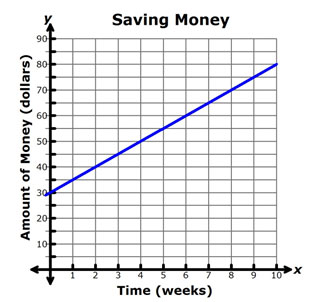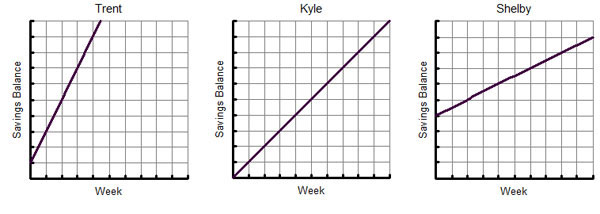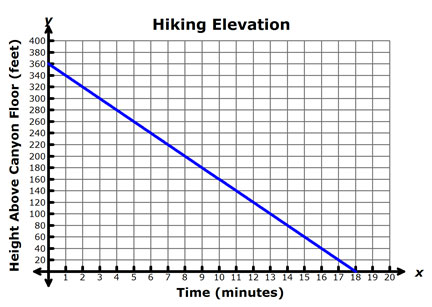
In a previous resource you learned about how changes in m and b affect the graph of y = mx + b. In other words, the slope, m, affects the steepness of the graph, and the y-coordinate of the y-intercept, b, affects where the graph crosses the y-axis.
Bethany received $30 from her favorite aunt for her birthday. She wants to save her money to purchase an e-reader. She decided to save the $30 and add $5 from her own money each week. The amount of money that she has saved as a function of time is shown in the graph below.

Interactive popup. Assistance may be required.
(0, 30)
Interactive popup. Assistance may be required.
At the beginning (time = 0 weeks), Bethany has $30 in savings.
![]() Bethany wants to consider several different savings options as compared to the one shown in the graph above. In the interactive below, match each graph with the situation that best describes what you notice about the y-intercept in the graph.
Bethany wants to consider several different savings options as compared to the one shown in the graph above. In the interactive below, match each graph with the situation that best describes what you notice about the y-intercept in the graph.
How can you tell if a situation will increase or decrease the y-intercept?
Interactive popup. Assistance may be required. If the starting point in a situation increases, so will the y-intercept. If the starting point in a situation decreases, so will the y-intercept.
Use the graphs below to answer questions 1 and 2. The graphs represent the savings of three students.

Interactive popup. Assistance may be required.
Which graph has the y-intercept with the least y-coordinate? Interactive popup. Assistance may be required.
Kyle, who began saving with $0.
Interactive popup. Assistance may be required.
Kyle, who began saving with $0.
Interactive popup. Assistance may be required.
Which graph has the y-intercept with the greatest y-coordinate? Interactive popup. Assistance may be required.
Shelby
Interactive popup. Assistance may be required.
Shelby

If her friend, Eduardo, began hiking 25 feet higher than Denise, what would be the y-intercept of the graph of Eduardo’s hiking elevation versus time?
Interactive popup. Assistance may be required.
According to the graph, what is the y-intercept of the function describing Denise’s hiking elevation versus time? Interactive popup. Assistance may be required.
(0, 385)
Interactive popup. Assistance may be required.
(0, 385)